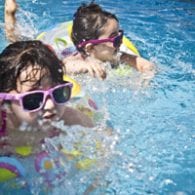Sun Protection for Children
Using sunscreen and sunglasses for sun protection is particularly important for children. In fact, studies show that excessive exposure to the sun during childhood increases the risk of skin cancer in adulthood. A young child’s eyes are also susceptible to irritation from the sun’s harsh glare.
To guard against problems now and later in life, it’s up to parents to take the necessary steps to protect their children’s skin and eyes from the damaging effects of the sun.
The FDA recommends that you ask your own physician about using sunscreen on babies under 6 months old, because babies’ skin is much thinner and sunscreen absorbs through it more easily. Since a baby’s surface area to body weight ratio is much higher, a baby’s exposure to sunscreen is much greater.
Tips to Keep Little Ones Safe from the Sun
- Avoid sun exposure from 10 am to 4 pm. These peak hours of the day are when the sun’s rays are most intense.
- Cover baby with a long, white, cotton shirt and a wide-brimmed hat. Try to use sun-protective clothing for children that offer an SPF of at least 30. Wet hand-me-down t-shirts provide an SPF of 6. (adult T-shirts work well)
- Place your infant or child under a large sun umbrella. Don’t forget to protect baby from sun’s rays reflecting off the water and white sand.
- Cover your child with sunscreen. Choose a product that’s gentle but effective for tender young skin. Be sure to apply an opaque zinc oxide generously and repeatedly to particularly exposed areas, such as the nose, cheeks and ears.
- Apply lip balm with an SPF (sun protection factor) of at least 15. This will help give your child’s lips sun protection and prevent blisters.
The American Academy of Dermatology recommends that people use a water resistant sunscreen with an SPF of at least 30 for proper sun protection. Sunscreen should be applied liberally to all exposed areas on dry skin (especially the face, ears, hands and arms) and rubbed in thoroughly 15 to 30 minutes BEFORE going outside, as the sunscreen must work its way into the skin. Remember to re-apply sunscreen again after swimming, sweating or towel drying.
It is estimated that over 3 million Americans each year develop skin cancer, and women have a higher incidence of skin cancer than men. Most skin cancer is curable if detected early, however melanoma that has spread throughout the body can be fatal.
Understanding Sunscreen Lingo
SPF – Stands for Sun Protection Factor: These numbers refer to the product’s ability to deflect the sun’s burning rays (UVB).
- SPF 15 – Blocks 93% of UVB radiation
- SPF 30 – Blocks 97% of UVB radiation
- SPF 50+ – Blocks 98% of UVB radiation
- Sunscreens with a higher SPF should offer more sun protection from harmful ultraviolet (UV) radiation. UV radiation has been linked to most skin cancers, premature skin aging and eye damage.
- There are two different types of UV radiation, UVB and UVA. UVB plays a role in skin cancer and SPF refers mainly to the amount of UVB protection a sunscreen offers.
- When SPF is evaluated for its effectiveness, the amount applied is 2 mg of sunscreen per square centimeter of skin (this amount is about the size of 2 raisins). Most people, however, apply much less sunscreen than is required for effective sun protection.
- It is important to apply sunscreen to all exposed areas on dry skin 15 – 30 minutes BEFORE exposure to the sun. This allows the sunscreen to soak into the skin to provide protection.
- Reapply sunscreen about every 2 hours and especially after sweating, swimming or towel drying, even on cloudy days.
- Water resistant sunscreens should be reapplied every 40 – 80 minutes depending on the level of protection the sunscreen provides.
Shade those Peepers
Your child’s eyes are also sensitive to the harmful effects of ultraviolet (UV) light. Children’s eyeballs can redden and swell from excessive sun exposure. In fact, one of our children recently had what we thought was conjunctivitis, until we noticed his eyes were redder after several hours in the sun without wearing sunglasses.
Eye specialists believe that toy sunglasses may actually be worse than no sunglasses at all. That’s because toy shades simply darken the eye area and enlarge baby’s pupils, allowing more damaging light to reach the inside of the eye. It’s best to use sunglasses labeled “100 percent UV filtration” for your baby—but expect to pay a higher price for this added protection. If your toddler is reluctant to wear sunglasses, keep a wide-brimmed hat nearby to shade her eyes. To get your child to wear a hat and sunglasses, first wear some funky ones yourself and your child will copy.

